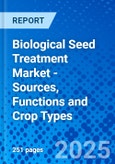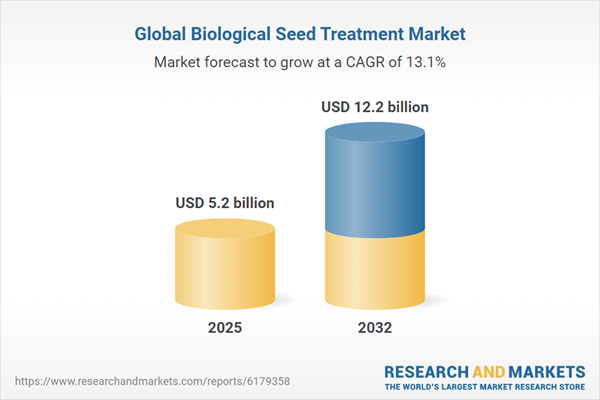The global biological seed treatment market, valued at about US$5.2 billion in 2025, is projected to reach US$12.2 billion by 2032, reflecting a strong 13.1% CAGR during 2025-2032. Growth is underpinned by the global shift toward sustainable and organic agriculture, driven by consumer demand for chemical-free produce and supportive government initiatives to limit synthetic inputs. Mounting pest and disease resistance in conventional crops is further propelling adoption, as biological treatments enhance plant resilience and yield stability. Advances in microbial formulation, precision seed coating, and digital farming are improving performance consistency, while the focus on soil health and climate-resilient cultivation reinforces their value. With accelerating uptake in emerging markets and active innovation introducing novel microbial strains and biostimulants, biological seed treatments are becoming central to modern, sustainable crop production worldwide.
Biological Seed Treatment Regional Market Analysis
North America accounts for the largest share of the global biological seed treatment market at an estimated 33.7% in 2025, supported by advanced agricultural infrastructure, high technology integration, and strong R&D investments that have improved seed performance, especially in corn through microbial and fungal applications. A growing preference for chemical-free produce and favorable policy frameworks promoting sustainable agriculture continue to sustain regional leadership. By contrast, Asia-Pacific is projected to register the most rapid expansion, with growth exceeding 14% annually between 2025 and 2032. This momentum reflects rising awareness of food safety, widespread adoption of organic and sustainable farming practices, and active government support. Major markets such as China, India, and Japan are accelerating progress through investment in agricultural biotechnology and microbial research to enhance crop productivity and reduce chemical dependency. The region's diverse cropping systems and strong demand for food security position it as a vibrant hub for innovation and large-scale adoption of biological seed treatments.Biological Seed Treatment Market Analysis by Source
Microbials represent the largest source category in the biological seed treatment market, contributing around 63.2% of global value in 2025. Their leadership stems from the proven efficacy of beneficial microorganisms such as Rhizobia, Bacillus, Pseudomonas, Streptomyces, Trichoderma, and mycorrhizae in boosting nutrient uptake, improving soil fertility, and protecting crops from soil-borne pathogens. The segment's widespread acceptance reflects its compatibility with regenerative and sustainable farming practices, where eco-friendly microbial solutions increasingly replace synthetic agrochemicals. Continued innovation in formulation technologies (such as polymer coatings and biopriming) has further strengthened market confidence by improving shelf life and field consistency. In comparison, the botanicals segment is poised for the fastest advance, projected to grow at about 13.7% annually through 2032. Rising demand for plant-derived alternatives to synthetic pesticides and the global shift toward organic production are fueling uptake. Extracts from neem, garlic, and water pepper offer natural pesticidal properties while enhancing germination and seed vigor, aligning with farmers' need for safe, sustainable, and residue-free solutions.Biological Seed Treatment Market Analysis by Function
Seed Enhancement accounts for approximately 52.4% of the biological seed treatment market in 2025 and is expected to expand at a CAGR of 13.3% through 2032, making it both the largest and most rapidly growing function. This strong performance is underpinned by the increasing use of biofertilizers and biostimulants to improve germination, root establishment, nutrient uptake, and abiotic stress tolerance, particularly in major crops like cereals, oilseeds, and vegetables. Growing environmental awareness, declining soil health, and a global shift toward sustainable production systems have amplified demand, supported by advances in precision agriculture and coating technologies that enhance uniformity and efficiency. At the same time, the Seed Protection segment continues to gain ground as stricter pesticide regulations and rising incidences of seed-borne pests and pathogens prompt greater reliance on biofungicides, bioinsecticides, and bionematicides. These solutions are increasingly vital for high-value export crops requiring residue-free protection, helping farmers integrate biological agents into comprehensive pest management programs that balance productivity with ecological safety.Biological Seed Treatment Market Analysis by Crop Type
Cereals and grains represent the largest application area for biological seed treatments, capturing about 41% of the global market in 2025. Their extensive use across staple crops (such as wheat, corn, rice, and barley) reflects the sector's central role in food security and the growing dependence on biological inputs to maintain yields while curbing chemical use. Farmers increasingly apply microbial agents to improve germination, nutrient absorption, and resistance against seed- and soil-borne pathogens like Fusarium and Cercospora, ensuring healthier and more resilient crops. In contrast, fruits and vegetables are emerging as the most dynamic segment, projected to grow by roughly 14% annually through 2032. Rising consumer preference for organic, residue-free produce and tightening food safety standards are key growth drivers. Biological treatments help enhance seedling vigor, root development, and early-stage disease resistance in high-value horticultural crops such as tomatoes, peppers, and leafy greens. Expanding organic and protected cultivation systems, along with increasing awareness of health benefits, continue to accelerate adoption across this segment.Biological Seed Treatment Market Report Scope
This global report on Biological Seed Treatment analyzes the market based on source, function, and crop type. In addition to providing profiles of major companies operating in this space, the latest corporate and industrial developments have been covered to offer a clear panorama of how and where the market is progressing.Key Metrics
- Historical Period: 2022-2024
- Base Year: 2025
- Forecast Period: 2025-2032
- Units: Value market in US$
- Companies Mentioned: 10+
Biological Seed Treatment Market by Geographic Region
- North America (The United States, Canada, and Mexico)
- Europe (Germany, France, the United Kingdom, Italy, Spain, and Rest of Europe)
- Asia-Pacific (Japan, China, India, South Korea, and Rest of Asia-Pacific)
- South America (Brazil, Argentina, and Rest of South America)
- Rest of World
Biological Seed Treatment Market by Source
- Microbial
- Botanical
- Other Sources (Including Bio-Fermentation Metabolites, Natural Polymers, Endophytes, Synthetic Microbial Communities (SynComs), Plant-Incorporated Protectants (PIPs), And Other Derived Products)
Biological Seed Treatment Market by Function
- Seed Protection
- Seed Enhancement
Biological Seed Treatment Market by Crop Type
- Cereals & Grains
- Oil Seeds & Pulses
- Fruits & Vegetables
- Other Crop Types (Including Turf & Ornamental Plants, Plantation Crops, Medicinal Plants, and Others)
This product will be delivered within 2-4 business days.
Table of Contents
Companies Mentioned
- BASF SE
- Bayer AG
- BioWorks Inc.
- Corteva, Inc.
- Germains Seed Technology
- Hello Nature International Srl
- Koppert B.V.
- Novonesis
- Plant Health Care plc.
- Precision Laboratories, LLC
- Syngenta AG
- Valent BioSciences LLC
- Verdesian Life Sciences LLC
Table Information
| Report Attribute | Details |
|---|---|
| No. of Pages | 251 |
| Published | October 2025 |
| Forecast Period | 2025 - 2032 |
| Estimated Market Value ( USD | $ 5.2 billion |
| Forecasted Market Value ( USD | $ 12.2 billion |
| Compound Annual Growth Rate | 13.1% |
| Regions Covered | Global |
| No. of Companies Mentioned | 13 |









